Think Like an Entrepreneur: Strengthening Management Skills Through Mindset Shifts
Entrepreneurship is more than launching a product or service—it’s a transformative journey that demands a mindset rooted in innovation, resilience, and strategic foresight. While traditional management may rely on established processes and predictability, entrepreneurship thrives in environments of uncertainty and change. It’s about seeing opportunities where others see obstacles, making bold decisions, and staying adaptable in facing challenges.
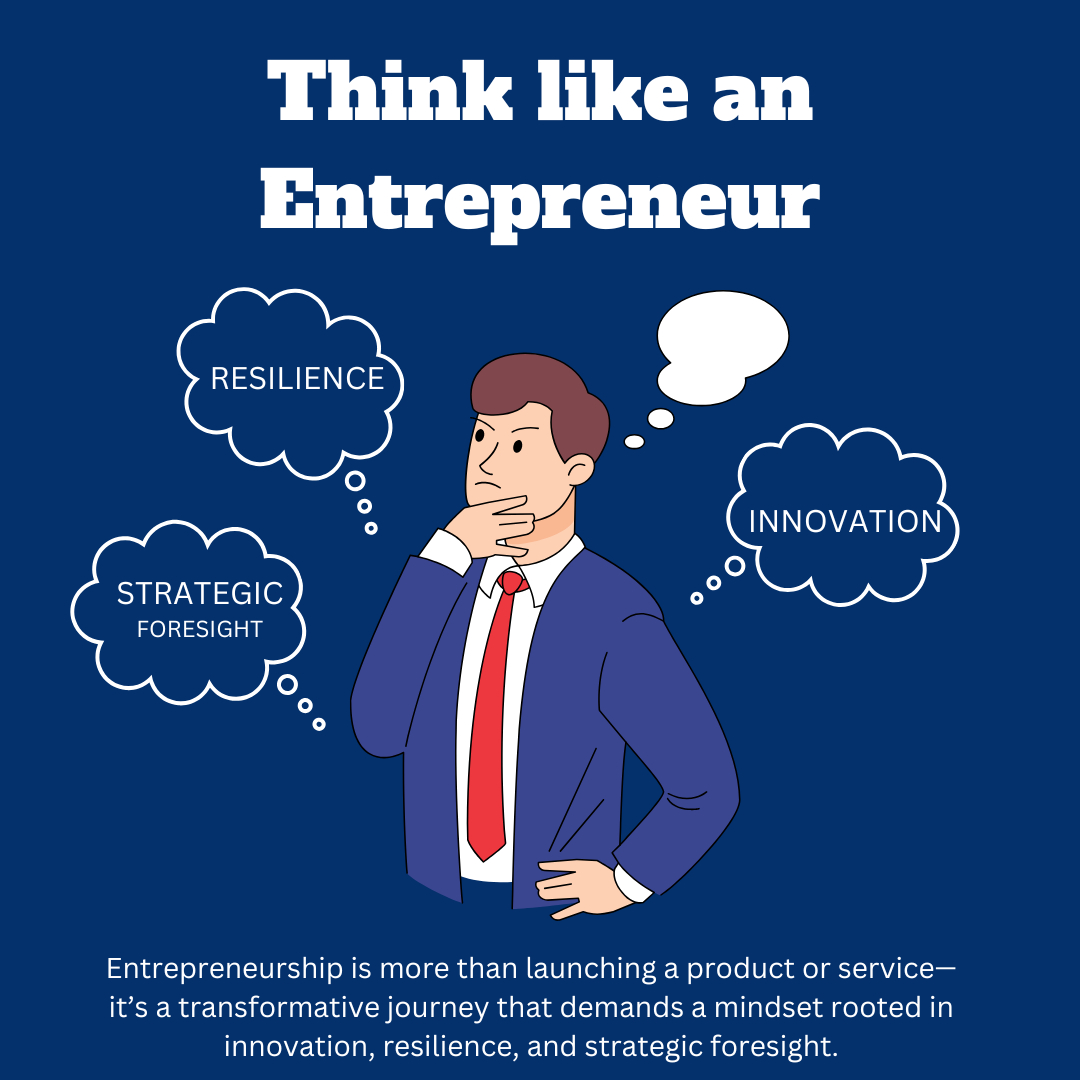
Strengthening management skills with an entrepreneurial mindset equips leaders with the tools to overcome barriers, capitalize on emerging trends, and create a sustainable foundation for long-term success. This mindset fosters creativity, empowers strategic planning, and encourages a proactive approach to solving problems.
Unlike traditional managers, entrepreneurs focus on adaptability, customer-centric solutions, financial resourcefulness, and fostering leadership within their teams. These traits are beneficial and essential for navigating the complexities of building and scaling a business in today’s competitive landscape.
This article delves into six key points to help entrepreneurs adopt these vital mindset shifts. By embracing these strategies, you can not only strengthen your management skills but also create a robust framework for startup planning and strategy, positioning your business for sustained growth and success.
1. Shift from Problem-Solving to Problem-Prevention
Entrepreneurs excel by adopting a proactive mindset, anticipating challenges before they arise, and taking measures to prevent them. This shift from reacting to problems to proactively managing risks is crucial for maintaining operational efficiency and minimizing disruptions. Problem prevention not only saves time and resources but also fosters confidence among stakeholders by demonstrating foresight and preparedness.
Example:
Imagine a startup developing a new mobile app. Instead of waiting to address bugs reported post-launch, the company invests in robust testing tools, such as automated quality assurance software, and builds contingency plans for handling unexpected delays. By adopting this approach, the startup ensures a smoother launch, maintains user satisfaction, and avoids potential backlash from releasing a faulty product.
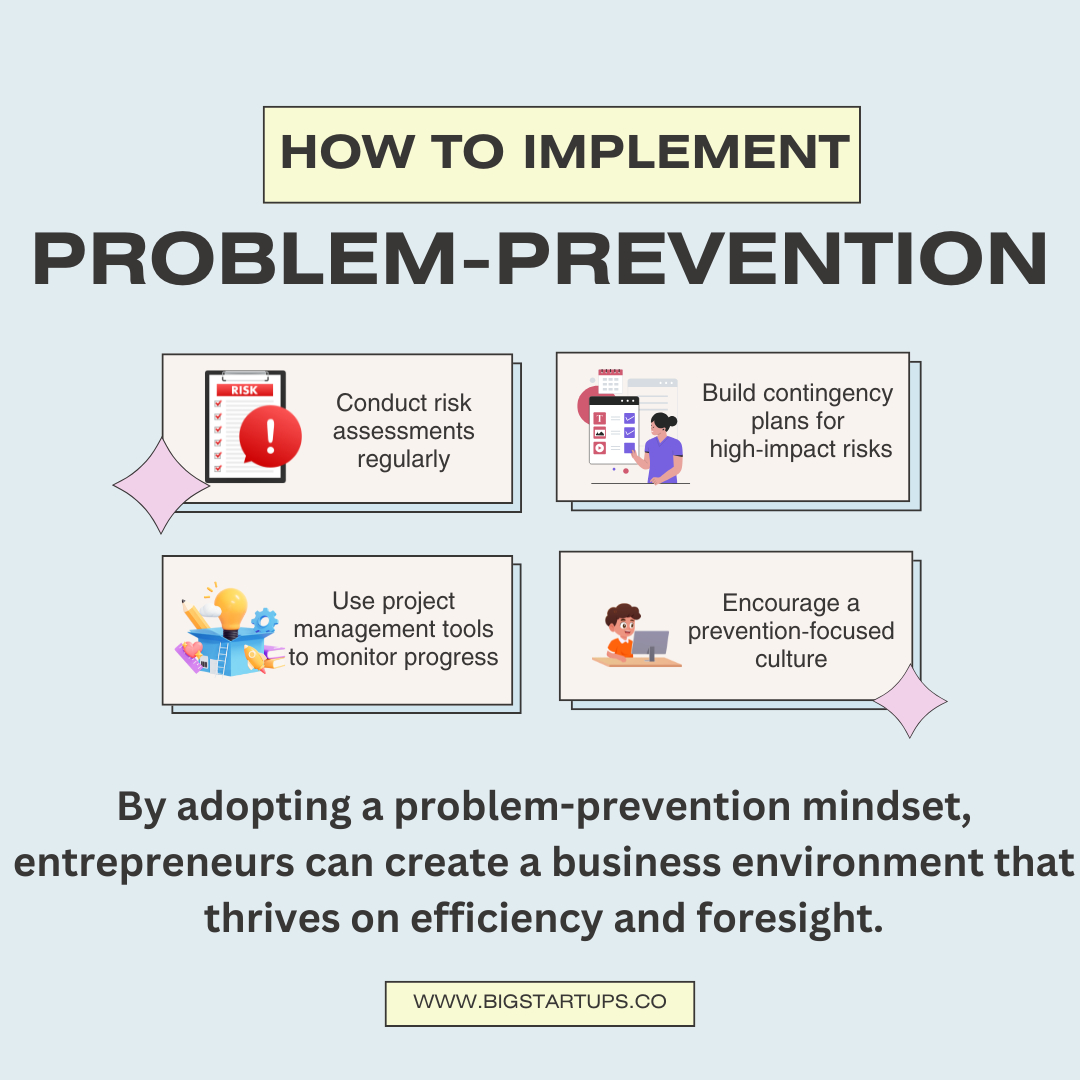
How to implement problem-prevention:
Conduct risk assessments regularly:
- Evaluate your business processes to identify potential vulnerabilities.
- Involve your team in brainstorming sessions to uncover hidden risks.
- Use risk assessment matrices to prioritize and address the most critical threats.
Build contingency plans for high-impact risks:
- Develop clear, actionable plans for scenarios like supply chain disruptions, data breaches, or regulatory changes.
- Assign roles and responsibilities to ensure your team is prepared to act quickly when needed.
- Review and update contingency plans periodically to reflect new challenges or changes in the business environment.
Use project management tools to monitor progress:
- Leverage tools like Trello, Asana, or Jira to track the progress of tasks and flag potential delays early.
- Set up automated notifications and dashboards to keep stakeholders informed.
- Implement metrics to measure project health, such as deadlines met, budgets maintained, and quality benchmarks achieved.
Encourage a prevention-focused culture:
- Train your team to think critically about potential risks in their areas of responsibility.
- Reward proactive behavior that prevents problems from occurring.
- Foster open communication, so team members feel comfortable raising concerns before they become significant issues.
By adopting a problem-prevention mindset, entrepreneurs can create a business environment that thrives on efficiency and foresight. This proactive approach not only ensures smoother day-to-day operations but also builds a strong reputation for reliability and strategic thinking—qualities that are indispensable for long-term success.
2. Develop a growth-oriented mindset
A growth-oriented mindset is a hallmark of successful entrepreneurs. It drives them to look beyond short-term wins and focus on building a scalable, sustainable business. This mindset encourages innovation, calculated experimentation, and continuous learning, enabling entrepreneurs to adapt to changing market demands and unlock new opportunities.
Growth-oriented entrepreneurs prioritize expansion—whether it's by enhancing products and services, exploring new markets, or refining processes to increase efficiency. They view challenges as stepping stones rather than obstacles and remain committed to long-term progress, even in the face of setbacks.
Example:
Dropbox exemplifies the growth mindset. Initially, it offered a simple file-sharing service aimed at individual users. By identifying unmet market needs, Dropbox expanded its offerings to include collaborative tools for businesses, such as Dropbox Business, and integration with third-party applications. This evolution not only broadened its customer base but also solidified its position as a leader in cloud-based solutions.
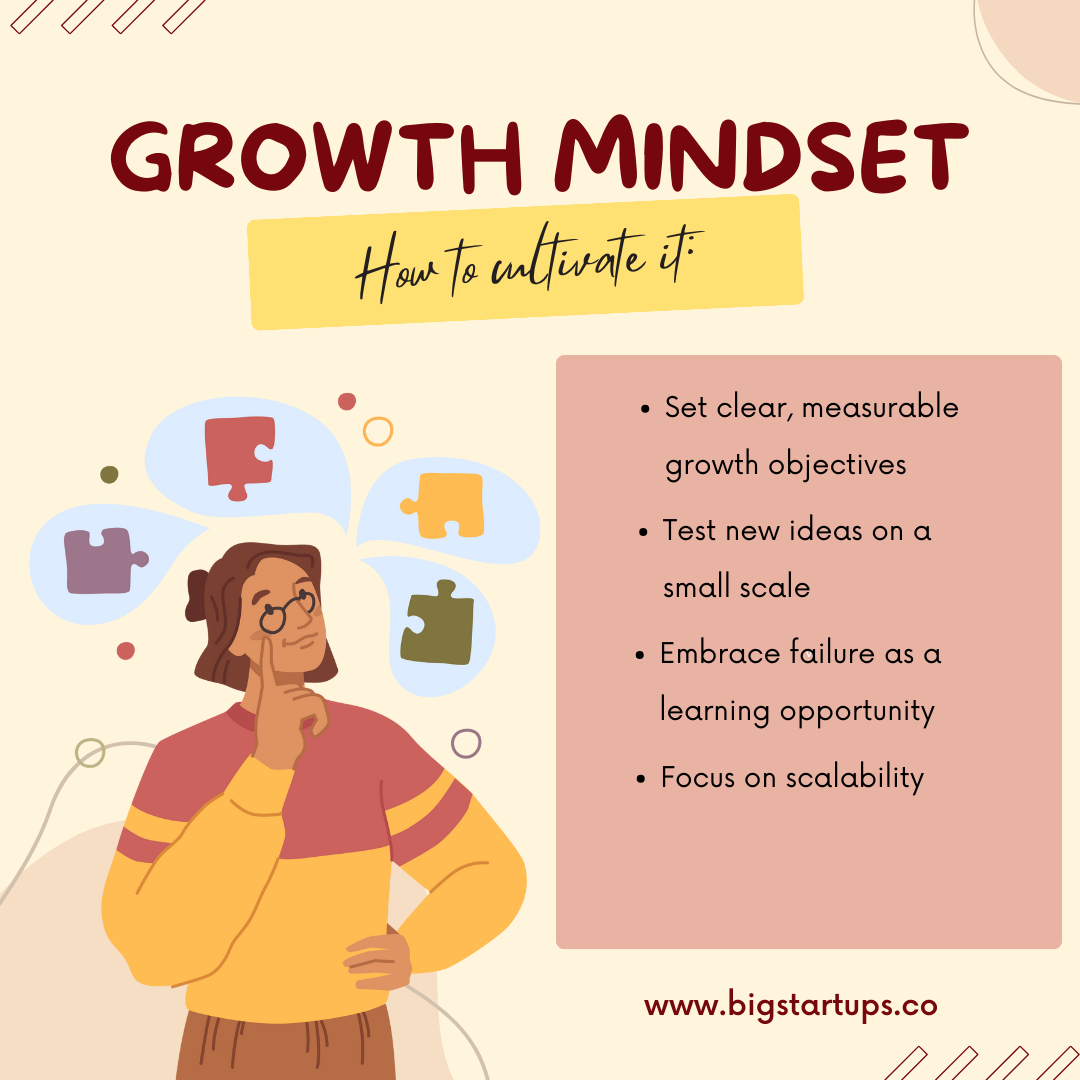
How to cultivate a growth-oriented mindset:
Set clear, measurable growth objectives:
- Define your long-term vision and break it into actionable, time-bound goals.
- Use frameworks like OKRs (Objectives and Key Results) to align team efforts with growth targets.
- Continuously evaluate progress using metrics like customer acquisition rate, revenue growth, or market share.
Test new ideas on a small scale:
- Launch pilot projects or minimum viable products (MVPs) to validate concepts before committing significant resources.
- Gather customer feedback and use it to refine your offerings.
- Embrace agile methodologies to iterate quickly and efficiently.
Example: A food delivery startup could test a new subscription-based model in a single city before scaling it nationwide.
Embrace failure as a learning opportunity:
- Analyze failed experiments to uncover valuable insights.
- Create a culture that encourages risk-taking and views setbacks as part of the innovation process.
- Document lessons learned to improve decision-making in future initiatives.
Focus on scalability:
- Evaluate your current operations to identify processes that can be automated or optimized for growth.
- Invest in technology, tools, and infrastructure that support scalability.
- Develop partnerships or collaborations that open doors to larger markets or new customer segments.
Example: A SaaS company could streamline its onboarding process by automating tutorials, making it easier to onboard a large number of customers as it grows.
Stay curious and adaptable:
- Keep abreast of market trends and emerging technologies.
- Regularly seek feedback from customers, employees, and stakeholders to identify areas for improvement.
- Adapt your strategy based on new insights, ensuring you remain competitive and relevant.
By developing a growth-oriented mindset, entrepreneurs can drive their businesses toward sustained success. The willingness to experiment, adapt, and scale ensures that you’re not just keeping pace with competitors but also setting the standard for innovation and growth in your industry.
3. Emphasize vision-driven leadership
Vision-driven leadership is the cornerstone of entrepreneurial success. A compelling vision serves as a guiding star, shaping decisions, inspiring teams, and uniting stakeholders around a common purpose. Entrepreneurs with a strong vision are not only able to navigate challenges effectively but also build a sense of purpose that drives innovation and long-term growth.
Example: SpaceX
SpaceX’s mission, "to make space exploration affordable and accessible for all," is a quintessential example of vision-driven leadership. This ambitious goal shapes the company’s strategic decisions, from investing in reusable rocket technology to designing spacecraft capable of colonizing Mars.
The clarity and audacity of this vision have not only motivated SpaceX employees to overcome immense technical challenges but have also attracted substantial investor interest. The company’s vision inspires a sense of purpose and urgency, pushing the boundaries of what’s possible in aerospace innovation.
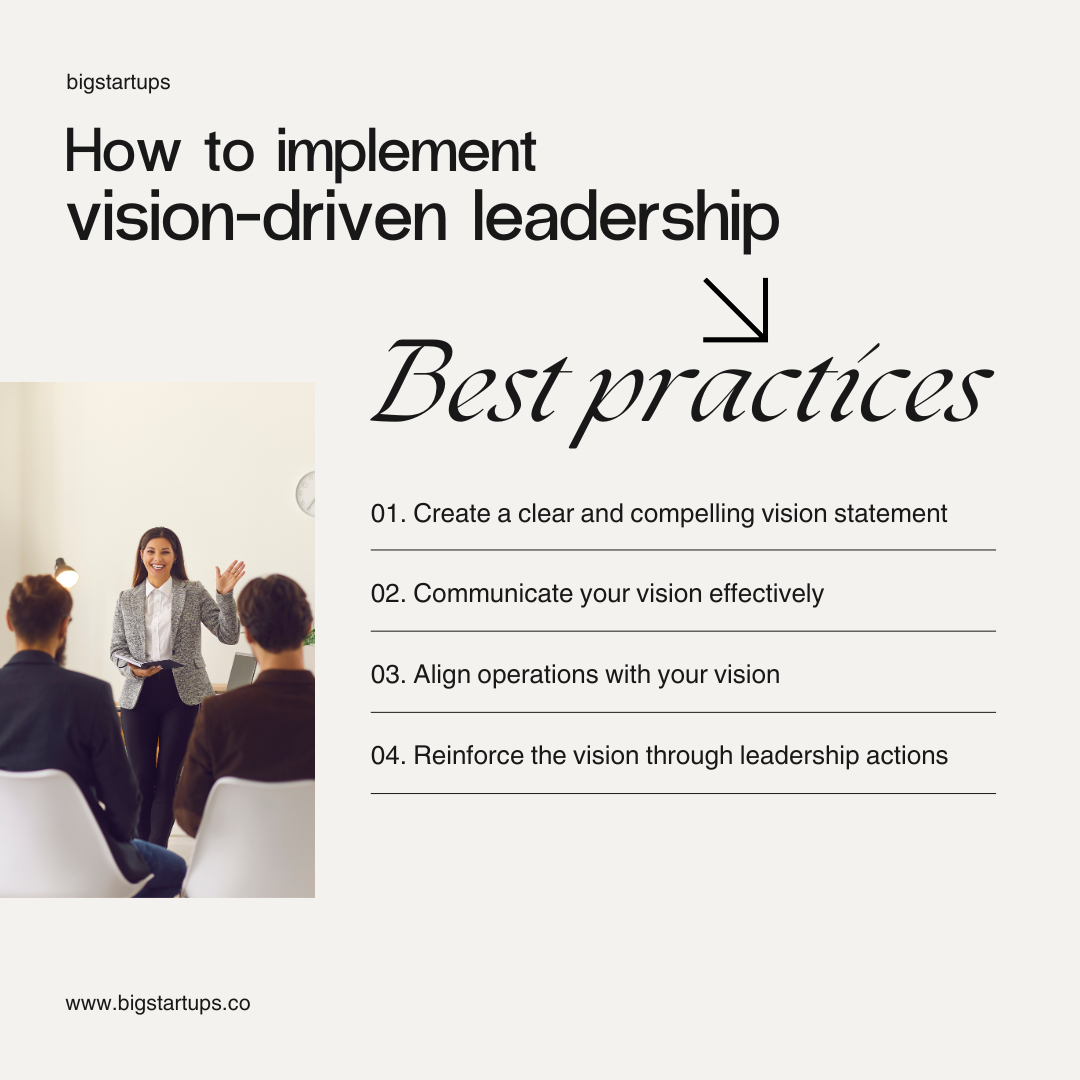
How to implement vision-driven leadership
Create a clear and compelling vision statement:
- Define the why behind your business. What problem are you solving? What change are you creating?
- Ensure the vision is ambitious yet achievable, inspiring both your team and external stakeholders.
- Use language that resonates emotionally and intellectually.
Example: A sustainable fashion startup could articulate a vision like, “To revolutionize the fashion industry by making sustainability the standard, not the exception.”
Communicate your vision effectively:
- Share your vision frequently with your team, investors, and customers. Make it a part of your company’s culture.
- Use storytelling to convey the meaning and importance of your vision. Highlight real-world examples of how your company is working toward it.
- Incorporate your vision into onboarding programs, marketing materials, and investor pitches to ensure alignment across all touchpoints.
Example: During team meetings, SpaceX leaders frequently emphasize the role of individual contributions in achieving the larger mission of Mars colonization, connecting day-to-day work with the company’s broader goals.
Align operations with your vision:
- Ensure every decision, project, and process aligns with your vision. From product development to marketing strategies, your vision should act as a filter for prioritizing initiatives.
- Set measurable goals that reflect progress toward your vision. Break these into short-term objectives to keep teams motivated.
- Encourage team members to challenge ideas or actions that stray from the vision, fostering accountability and consistency.
Example: A renewable energy company focused on reducing carbon emissions might prioritize projects that maximize environmental impact, even if they initially appear less profitable.
Reinforce the vision through leadership actions:
- Lead by example. Show your commitment to the vision in your daily actions and decisions.
- Celebrate milestones that move your company closer to its vision, reinforcing its importance.
- Be open to feedback and evolve the vision if market conditions or customer needs shift.
Example: A founder whose vision involves community upliftment might actively participate in local initiatives, demonstrating alignment between personal values and company goals.
Vision-driven leadership is not just a tool for guiding a business—it’s a philosophy that transforms the way a company operates and interacts with the world. By creating and living your vision, you’ll not only inspire your team but also position your startup as a force for meaningful change in its industry.
4. Why a Customer-First Approach Matters
Customers are the lifeblood of any business. Satisfied customers are more likely to become repeat buyers, refer your brand to others, and provide valuable feedback that shapes future offerings. In today’s competitive landscape, a company’s ability to provide exceptional customer experiences often determines its long-term success.
A customer-first approach also fosters trust and credibility, key factors in building a sustainable brand. Businesses that genuinely prioritize their customers are rewarded with loyalty and positive word-of-mouth, which can have a far-reaching impact on brand growth.
Example: Apple
Apple exemplifies a customer-first mindset by focusing on user experience at every touchpoint. From intuitive product design to premium customer service, Apple places customer satisfaction at the core of its strategy. For instance, the sleek, user-friendly interfaces of iPhones and MacBooks reflect Apple’s commitment to making technology accessible and enjoyable.
Moreover, Apple’s investment in after-sales services—such as the Genius Bar and AppleCare—ensures that customers receive support long after their purchase. This commitment to customer satisfaction has helped Apple achieve unparalleled brand loyalty and market leadership.
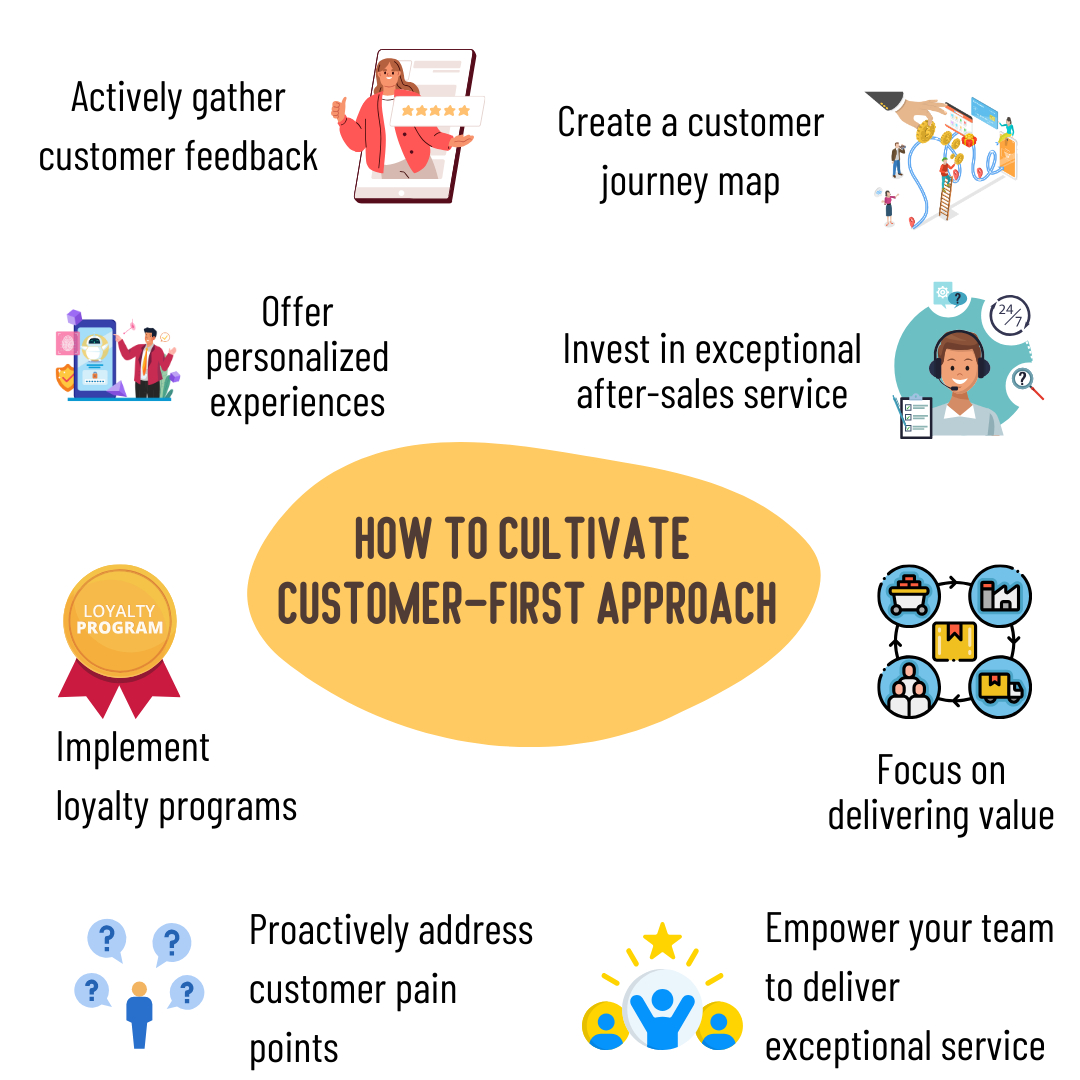
How to cultivate a customer-first approach:
Actively gather customer feedback:
- Conduct surveys, interviews, and focus groups to understand customer preferences and pain points.
- Use feedback to improve products, services, and customer interactions continuously.
- Monitor online reviews and social media mentions to stay aware of customer sentiments.
Example: A fitness app could send surveys to users asking for feedback on features, helping the company refine its offerings to better meet user needs.
Create a customer journey map:
- Analyze the end-to-end experience customers have with your brand, from awareness to purchase and beyond.
- Identify friction points where customers may face challenges or dissatisfaction.
- Optimize these touchpoints to create a seamless, enjoyable experience.
Example: An e-commerce company might notice high cart abandonment rates and simplify its checkout process by reducing unnecessary steps.
Offer personalized experiences:
- Leverage data to tailor products, services, and communications to individual customers.
- Use tools like CRM software to segment customers and create targeted marketing campaigns.
- Personalization builds stronger emotional connections and makes customers feel valued.
Example: Spotify creates personalized playlists like “Discover Weekly,” making each user’s experience unique and relevant.
Invest in exceptional after-sales service:
- Ensure customers receive timely and effective support after their purchase.
- Provide multiple channels for assistance, such as live chat, phone support, or email.
- Address issues promptly and empathetically to turn challenges into opportunities for strengthening relationships.
Example: A tech startup could offer 24/7 customer support to help users troubleshoot software issues, reinforcing trust in the brand.
Implement loyalty programs:
- Reward repeat customers with discounts, exclusive offers, or points redeemable for future purchases.
- Design loyalty programs that enhance the customer experience and encourage long-term engagement.
Example: Starbucks’ rewards program allows customers to earn points with each purchase, fostering loyalty while encouraging repeat visits.
Focus on delivering value:
- Go beyond selling products by solving real problems and fulfilling deeper customer needs.
- Educate customers through content, workshops, or other resources to help them make informed decisions.
Example: A skincare brand might offer free tutorials on creating personalized skincare routines, adding value beyond its products.
Proactively address customer pain points:
- Anticipate common challenges or frustrations and provide solutions in advance.
- Use customer complaints as opportunities to improve and innovate.
Example: An airline could offer real-time flight updates and alternate travel arrangements during delays to reduce passenger stress.
Empower your team to deliver exceptional service:
- Train employees to embody a customer-first mindset in every interaction.
- Empower them to resolve issues independently without unnecessary bureaucracy.
- Recognize and reward employees who go above and beyond for customers.
Example: Zappos, known for its outstanding customer service, allows employees to spend as much time as needed to resolve customer issues, even if it means exceeding typical expectations.
A customer-first approach is not just a strategy—it’s a commitment to creating genuine, meaningful relationships with those you serve. By making customers the focal point of your business, you set the stage for sustainable growth and long-term success.
5. Optimize Time Management
For entrepreneurs, time is one of the most valuable yet limited resources. With numerous responsibilities and competing demands, mastering time management is essential to staying productive and focused. Effective time management doesn’t just mean working harder—it means working smarter by prioritizing high-impact tasks, minimizing distractions, and leveraging tools and resources to streamline efforts.
Entrepreneurs who optimize their time can achieve more in less time, reduce stress, and create a balanced approach to managing their ventures. This focus on efficiency also sets the tone for the entire team, fostering a culture of productivity.
Example: Elon Musk
Elon Musk, known for managing multiple high-pressure ventures like Tesla, SpaceX, and Neuralink, optimizes his time through an unconventional approach—dividing his day into five-minute blocks. Each block is dedicated to specific tasks, ensuring that no minute goes to waste. This meticulous scheduling enables Musk to focus on critical tasks across his companies while maintaining progress on strategic goals.
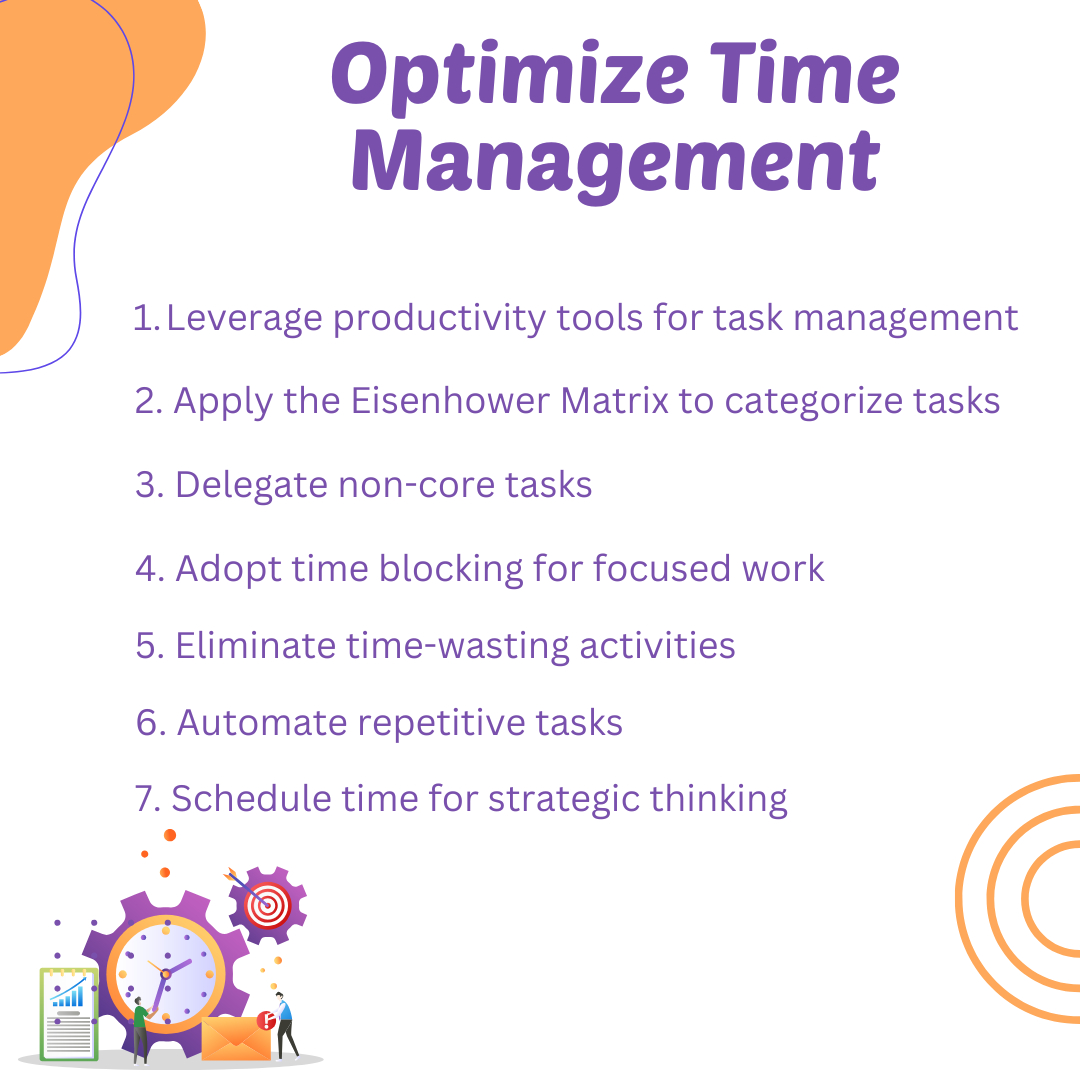
How to master time management:
Leverage productivity tools for task management:
- Use platforms like Trello, Asana, or Notion to organize tasks, set deadlines, and monitor progress.
- Categorize tasks based on urgency and importance to ensure clarity and focus.
- Implement calendar tools such as Google Calendar to schedule meetings and allocate time blocks for deep work.
Example: A startup founder can create Trello boards for different business areas like marketing, operations, and product development to streamline team collaboration and task tracking.
Prioritize using frameworks:
- Apply the Eisenhower Matrix to categorize tasks:
- Urgent and Important: Do these immediately.
- Important but Not Urgent: Schedule these for later.
- Urgent but Not Important: Delegate these tasks.
- Neither Urgent nor Important: Eliminate or deprioritize these.
- Regularly review priorities to adjust for shifting goals or deadlines.
Example: An entrepreneur launching a product might prioritize finalizing the prototype (urgent and important) while scheduling long-term branding strategies (important but not urgent).
Delegate non-core tasks:
- Identify tasks that others can perform as effectively—or more so—than you.
- Empower team members or hire virtual assistants to handle routine or time-consuming activities.
- Focus your energy on high-value activities, such as strategic decision-making and relationship building.
Example: Delegating administrative tasks like scheduling meetings or handling customer support frees up time for an entrepreneur to concentrate on securing investor funding.
Adopt time blocking for focused work:
- Divide your day into blocks dedicated to specific tasks or themes, such as “morning for planning” or “afternoon for creative work.”
- Avoid multitasking within these blocks to maintain focus and productivity.
- Include breaks between blocks to recharge and prevent fatigue.
Example: A founder could set aside the first two hours of their day for deep work, such as writing a business plan, without interruptions.
Eliminate time-wasting activities:
- Identify common distractions or low-value activities that consume time, such as excessive social media usage or unproductive meetings.
- Set boundaries to limit interruptions, like turning off notifications during focused work periods.
- Regularly audit your time to ensure it’s being used effectively.
Example: Scheduling a weekly review to analyze time spent can help entrepreneurs identify and eliminate inefficiencies.
Automate repetitive tasks:
- Utilize technology to automate repetitive processes like email responses, invoicing, or customer onboarding.
- Invest in tools like Zapier or HubSpot to integrate workflows and reduce manual effort.
Example: Automating email marketing campaigns allows entrepreneurs to focus on personalizing high-value client interactions instead.
Schedule time for strategic thinking:
- Dedicate blocks of time to reflect on long-term goals, evaluate progress, and plan next steps.
- Use this time to identify bottlenecks or opportunities for growth that may not be obvious in daily operations.
Example: A weekly “strategy hour” can help entrepreneurs align day-to-day activities with the company’s overarching vision.
By mastering time management, entrepreneurs can create a structured, efficient workflow that maximizes their impact and accelerates the journey toward business success. Time is a non-renewable resource—manage it wisely, and it becomes one of your greatest assets.
6. Build Resilient Financial Strategies
Financial resilience is the backbone of any successful startup. Entrepreneurs must not only generate revenue but also manage finances effectively to ensure stability, scalability, and long-term growth. Resilient financial strategies enable businesses to weather challenges, adapt to market changes, and capitalize on opportunities without jeopardizing their operations.
Startups often face fluctuating revenues, unpredictable expenses, and external pressures like economic downturns. Building a robust financial foundation helps entrepreneurs mitigate these risks and maintain a steady trajectory toward their goals.
Example: Patreon
Patreon, a platform that empowers creators, exemplifies financial resilience through its subscription-based revenue model. By allowing fans to support creators with recurring payments, Patreon ensures a predictable and steady income stream for both the platform and its users. This approach not only reduces dependency on fluctuating one-time purchases but also provides financial stability for scaling its user base and platform features.

How to build resilient financial strategies:
Create detailed financial projections:
- Develop financial forecasts for the next 12–24 months, including revenue, expenses, and cash flow projections.
- Factor in potential scenarios, such as slower-than-expected sales or unexpected expenses, to prepare for uncertainties.
- Use financial modeling tools like Excel, QuickBooks, or Xero to track and analyze data effectively.
Example: A SaaS startup might project customer acquisition rates and calculate how those translate into subscription revenue, ensuring they have enough funds for marketing and operational costs.
Diversify revenue streams:
- Avoid relying solely on one product, service, or market. Explore multiple revenue sources to spread risk.
- Consider implementing complementary income streams, such as offering premium services, partnerships, or affiliate programs.
Example: A fitness app could add in-app purchases for personalized training plans or offer branded merchandise to supplement subscription revenue.
Master cash flow management:
- Monitor inflows and outflows regularly to maintain positive cash flow.
- Implement payment terms with customers and vendors that optimize cash liquidity.
- Set aside an emergency fund to cover unexpected expenses or slow revenue periods.
Example: A retail startup could negotiate longer payment terms with suppliers while incentivizing customers to pay upfront, ensuring smoother cash flow.
Choose the right revenue model:
- Select a revenue model aligned with your business goals and customer preferences, such as subscription-based, freemium, or commission-based.
- Test and refine the model to ensure it delivers consistent and scalable revenue.
Example: A content platform like Medium uses a subscription model, generating recurring income while maintaining a high-quality user experience.
Regularly review financial metrics:
- Track critical metrics such as customer acquisition cost (CAC), lifetime value (LTV), gross margins, and burn rate.
- Use these insights to identify inefficiencies, optimize costs, and improve profitability.
- Schedule monthly or quarterly financial reviews to stay on top of changes and adjust strategies.
Example: A D2C startup might identify that reducing packaging costs by 10% could significantly improve its profit margins without compromising quality.
By building resilient financial strategies, entrepreneurs can create a strong foundation for their startups, ensuring stability in the face of challenges and agility to capitalize on new opportunities. A well-managed financial approach is not just about survival—it’s about thriving in a competitive market.
Conclusion
Thinking like an entrepreneur is about shifting your mindset to focus on innovation, strategic planning, and adaptability. By developing a growth-oriented vision, prioritizing customers, leveraging technology, and strengthening financial and leadership skills, you lay a solid foundation for startup success.
Entrepreneurship is not merely a career—it’s a way of thinking. Adopt these mindset shifts, and you’ll be equipped to lead your business through challenges, scale new heights, and turn your vision into reality.







.png)






